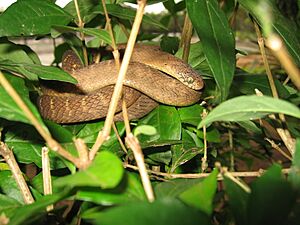Central African egg-eating snake facts for kids
Quick facts for kids Central African egg-eating snake |
|
|---|---|
 |
|
| Near Adum Banso, Ghana | |
| Conservation status | |
| Scientific classification | |
| Genus: |
Dasypeltis
|
| Species: |
fasciata
|
| Synonyms | |
|
|
The Dasypeltis fasciata, also known as the Central African egg-eating snake, is a special kind of snake found only in Africa. It belongs to a group of snakes called Colubridae. This snake is one of 13 types in its genus called Dasypeltis. Sometimes, people keep these snakes as pets because they are so unique, especially compared to other snakes like D. scabra and D. medici.
Contents
Where Does the Central African Egg-Eating Snake Live?
This snake lives in western and central parts of Africa. You can find it in countries like the Central African Republic, Gambia, Nigeria, and Uganda.
What Kind of Home Does It Like?
The D. fasciata snake loves to live in lowland forests. These are forests that are not very high up, usually between 1,000 and 1,150 meters (about 3,280 to 3,770 feet) above sea level.
How Do These Snakes Have Babies?
D. fasciata snakes are oviparous. This means they lay eggs, just like birds or turtles do.
How Does an Egg-Eating Snake Eat?
All snakes in the Dasypeltis group, including D. fasciata, are special because they only eat eggs. This is why they are called "egg-eating snakes"!
- Living in Trees: Because they hunt for bird nests, these snakes spend most of their time in trees.
- Night Hunters: They are active at night (nocturnal). This is when birds are usually sleeping, making it easier for the snakes to find unguarded eggs.
- No Teeth! These snakes don't have teeth. This might sound strange for a snake, but it helps them swallow whole eggs.
- Stretchy Necks: Their necks can stretch a lot, which lets them swallow eggs much wider than their own body.
- Crushing Eggs: Once an egg is in their neck, special bony parts from their backbone push against the egg. This crushes and cracks the shell.
- Drinking the Yolk: After the egg is cracked, the snake squeezes it to get all the liquid inside.
- Spitting Out Shells: They then spit out the empty, crushed eggshell.
- Breathing While Eating: When swallowing a big egg, they have a special windpipe that can flatten and move around the egg. This allows them to keep breathing even when their mouth is full!
This amazing way of eating helps them use a food source that almost no other animals compete for in their natural home.
Keeping Them as Pets
If you keep a D. fasciata as a pet, it's important to give them lots of things to climb on. This helps them stay active and happy, just like they would be in the wild.
- Size Differences: Like many snakes, male egg-eating snakes are usually smaller than females.
- What Eggs They Eat:
* Baby snakes and adult males often eat small eggs, like those from finches. * Some larger males can eat button quail eggs. * Adult female snakes can be big enough to eat full-sized quail eggs or even small chicken eggs!
- Wild Diet: In the wild, they only eat eggs that are very new. They cannot digest a baby bird that has started to form inside the egg.
How Do They Protect Themselves?
Since African egg-eating snakes don't have teeth, they can't bite to defend themselves. This is important for their diet, but it means they need other ways to stay safe from predators.
- Looking Like Dangerous Snakes: Many Dasypeltis snakes look a lot like other dangerous, venomous snakes, such as black mambas or vipers. This is called Batesian mimicry. Predators see them and think they are dangerous, so they stay away!
- Living Together: Because they can't harm other snakes, egg-eating snakes are one of the few types of snakes that can sometimes be kept together in the same enclosure when they are pets.
See also
- Garter snakes
- Ovivory
- Indian egg-eating snake


